Not to fully answer/solve the question, but just provide some interesting information around the subject:
Tubes of course have an exponential tail, just as semiconductor FETs do.
It's probably hard to make use of, though.
Once upon a time I characterized a 6AL5, and fit this model to it:

In code:
.SUBCKT 6AL5 1 2
B2 1 IDEAL V=((ABS(I(B2)) / 3.2m)^0.775) * (SGN(I(B2)) + 1) / 2
D1 IDEAL 3 6AL5_EXP
R2 IDEAL 2 12.7G
V2 3 2 -0.867
.ENDS
.MODEL 6AL5_EXP D (IS=66e-12 XTI=3.15 N=3.15 RS=0)
Note that a SPICE diode is used to express the exponential tail, which is apparent at low currents. (The N=3.15 implies either significant non-ideality (analogous to the semiconductor case), or a cathode temperature several times room temp, which seems reasonable enough -- room temp is ~300 K while the oxide-coated cathode is ~900 K.)
Note also the negative source: there is, in fact, current flow at zero voltage, and a small amount of power available (nanowatts) from a heated diode. It's a thermionic generator, of bafflingly low efficiency, but it is indeed thermodynamically realistic.
At higher currents (~uA?), the Child-Langmuir law takes over; here, not quite the ideal 3/2 power (or its reciprocal rather, for voltage in terms of current), but a little off, presumably due to material and geometry factors.
Since the exponential region is so small, I doubt that much use could be made of this, but perhaps a couple decades would be enough for some purposes.
More practical would be the same detailed analysis on the transfer function (of a triode or pentode, etc.), but which will I think quickly be dominated by leakage currents in most types. A more reliable solution probably involves a carefully contrived transfer function (see the other answer's use of a remote-cutoff pentode*), quirks of the screen-plate transfer function in a tetrode or pentode, or a multi-parameter curve fit (i.e., a dozen trimpots that all interact..).
*Carefully contrived, in the sense that, remote-cutoff types were contrived by way of varying the spacing of the grid wires; their characteristic isn't a direct result of intrinsic device properties (physics or geometry), in contrast to the diode's exponential tail which is.
